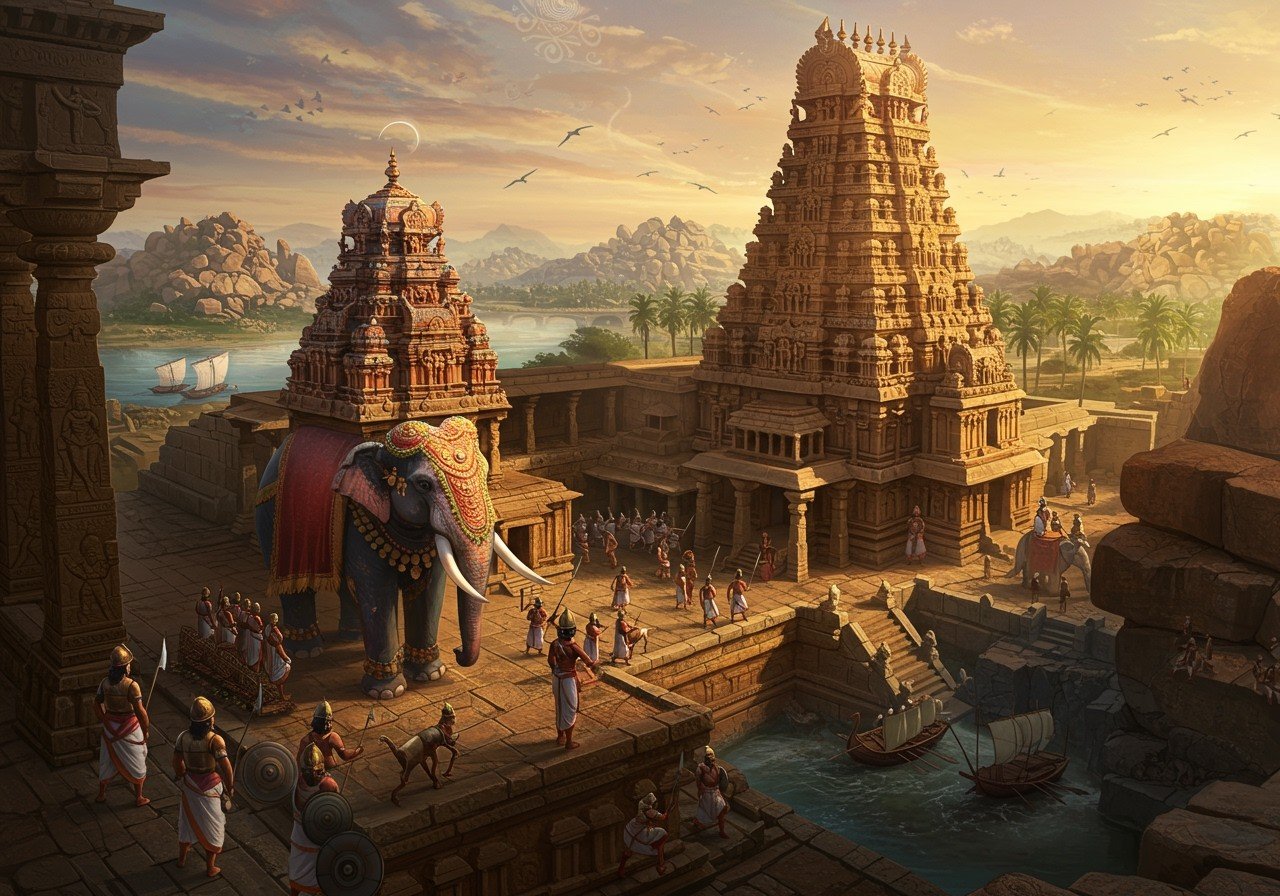
The Vijayanagara Empire, a formidable force in Southern India from 1336 to 1565, left an indelible mark on the region’s cultural, religious, and artistic landscape. Founded by brothers Harihara I and Bukka Raya I of the Sangama dynasty, this empire became a bastion of Hindu traditions, a testament to architectural ingenuity, and a patron of vibrant artistic expression. It served as a bulwark against the incursions of the Muslim sultanates to the north, fostering a resurgence of Hindu life and administration.
The Genesis and Rise of an Empire
The empire’s origins remain a subject of scholarly debate. Some historians posit a connection between the founders and the Telugu people, while others suggest they were Kannadigas. Regardless of their precise origins, the brothers established a powerful kingdom that quickly rose to prominence. Strategic alliances and shrewd military tactics, coupled with efficient governance and administrative reforms, ensured the empire’s stability and expansion. Hinduism served as a unifying force, knitting together the diverse populace and fostering a shared sense of identity. The empire’s economic prosperity, driven by robust agriculture, trade, and commerce, further solidified its position of power.
Architectural Marvels: Temples, Forts, and Urban Planning
The Vijayanagara Empire’s architectural legacy stands as a testament to its grandeur and artistic sophistication. The Dravidian style, characterized by intricately carved pillars, majestic gopurams (tower gateways), and the extensive use of granite and soapstone, is prominently showcased in the empire’s temples, forts, and urban design. Iconic temples like the Virupaksha Temple and Vittala Temple, renowned for their breathtaking carvings and musical pillars, exemplify the empire’s architectural prowess. The influence of Indo-Islamic architecture is evident in structures like the Lotus Mahal. Hampi, the empire’s capital, showcases meticulous urban planning, featuring the Royal Enclosure and a sophisticated network of aqueducts and canals.
Hampi: A Glimpse into a Lost World
Hampi, the former capital, now a UNESCO World Heritage site, offers a poignant glimpse into the empire’s glorious past. This once-thriving metropolis, a hub of power, culture, and trade, is now a collection of evocative ruins, including palaces, market streets, and temples. The city’s unique layout, with its Sacred Center and Royal Center, speaks to the empire’s sophisticated urban planning. Hampi was a magnet for artists, scholars, and traders from across the globe. Ongoing archaeological excavations continue to unveil its rich history, while myths and legends add to its mystique.
A Flourishing of Arts and Culture
The Vijayanagara Empire presided over a golden age of artistic and cultural expression. Literature flourished, with classical Telugu and Kannada poetry reaching new heights. Music and dance saw significant advancements, particularly Carnatic music and Bharatanatyam. Temple murals and frescoes stand as testaments to the empire’s achievements in painting. Royal patronage nurtured artistic talent and fostered cultural exchange, leaving an enduring legacy on South Indian traditions.
The Decline and Fall of a Mighty Empire
The empire’s decline began in the latter half of the 16th century, culminating in the devastating Battle of Talikota in 1565. Internal strife, including succession disputes and administrative challenges, weakened the empire from within. External threats from the Deccan Sultanates, who ultimately formed a coalition against Vijayanagara, further exacerbated the situation. The Battle of Talikota marked a turning point, leading to the destruction of Hampi and the scattering of its inhabitants. While the empire eventually crumbled, its legacy continues to resonate in the regions it once ruled.
Poojn.in: Connecting You to Vijayanagara’s Spiritual Heritage
Poojn.in, India’s leading provider of spiritual and puja items, offers a unique opportunity to connect with the rich traditions of the Vijayanagara Empire. Explore our extensive collection of authentic puja items, including:
- Brass and Copper Items: Discover handcrafted brass and copper puja accessories, reminiscent of those used in Vijayanagara temples, like this copper Ananda Kosha Kushi and this copper Kosha Kushi for Puja. These beautiful pieces bring a touch of history and tradition to your spiritual practices.
- Sacred Ritual Materials: Source authentic kumkum, vibhuti, and other essential puja materials, ethically sourced and prepared according to traditional methods. Our range of high-quality materials ensures a pure and authentic puja experience, connecting you to the spiritual heritage of the Vijayanagara Empire.
- Dhoop and Camphor: Enhance your puja rituals with our selection of premium dhoop and camphor. These aromatic offerings create a sacred atmosphere, evoking the spiritual essence of ancient Vijayanagara temples.
- Puja Thalis: Simplify your puja preparations with our curated puja thalis, complete with all the necessary items for a traditional ceremony. Our thalis are designed with both aesthetics and authenticity in mind, reflecting the rich heritage of the Vijayanagara period.
Experience the spiritual legacy of the Vijayanagara Empire. Visit Poojn.in today.


